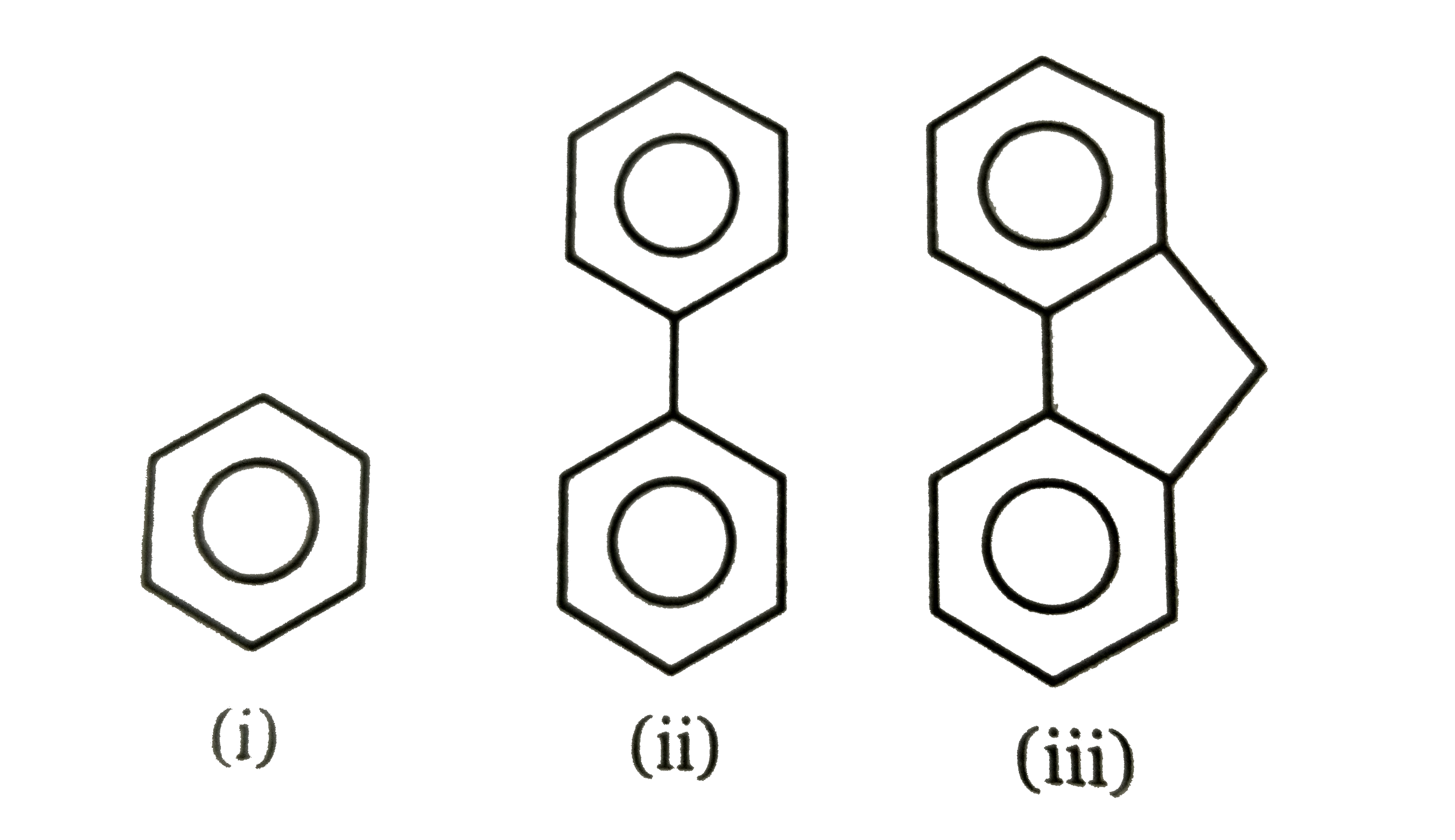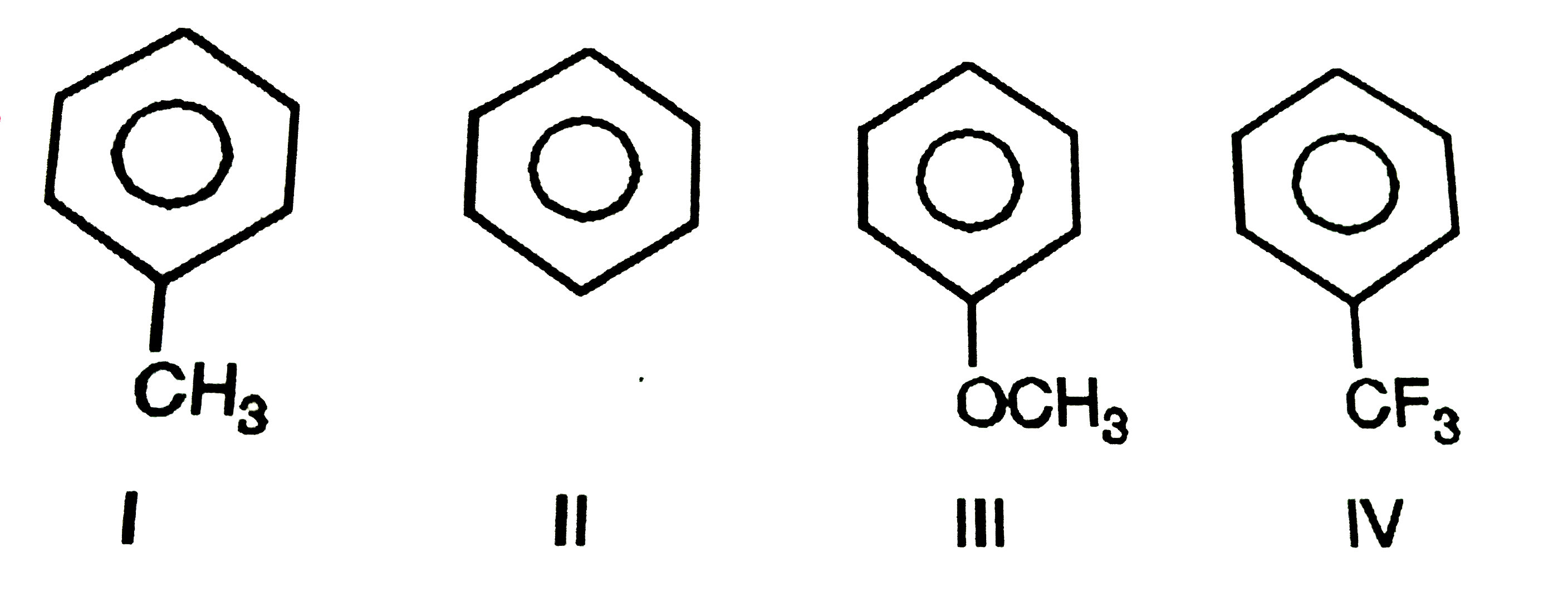Arrange in their decreasing order of rate of electrophilic aromatic substitution :
 Solution in Telugu
Solution in Telugu
i > ii > iii
iii > ii > i
iii > i > ii
i > iii > ii
The correct Answer is:B

The electron distribution in benzene is symmetrical and a pair of electrons become localised at the requirement of the electrophilic reagent. In biphenyl, one ring behaves as a +R group, thereby activating the other ring in the o- and p-positions. Hence, on the charge distribution approach, biphenyl can be expected to be more reactive than benzene towards electrophiles. The +R effect in biphenyl is transmitted from one ring to the other through the intramolecular bond. Maximum transmission is obtained if the two rings are coplanar, but because of the steric effects (weak) of the hydrogens in the o-positions, the two rings are being hindered from becoming coplanar. At the same time, biphenyl molecules in solution are subject to thermal agitation (.bombardment by other molecules), and this also tends to prevent the biphenyl molecule from becoming coplanar (in which state the molecule will have a minimum entropy). The overall result is that the resonance effect is partially nullified, i.e., the activation of one ring by the other through resonance is relatively weak. If we now consider fluorene, its unsaturated system is the same as that of biphenyl, but in the former, because it is a flat molecule due to the presence of the middle ring (formed by the methylene bridge), the +R effect of one benzene ring is completely transmitted to the other ring. Hence, fluorene can be expected to be more reactive than biphenyl towards electrophiles. If we consider the problern from the carbonium - ion stability approach, then the more extended the conjugation and the more nearly coplanar the resonating structures, the more stable are the resonance hybrids. We therefore arrive at the same order of reactivity as before by using the same arguments.
Topper's Solved these Questions
- AROMATIC COMPOUNDS BOOK - MS CHOUHANCHAPTER - AROMATIC COMPOUNDS EXERCISE - LEVEL-2
11 Videos
- AROMATIC COMPOUNDS BOOK - MS CHOUHANCHAPTER - AROMATIC COMPOUNDS EXERCISE - LEVEL-2 (COMPREHENSION)
16 Videos
- AMINESBOOK - MS CHOUHANCHAPTER - AMINESEXERCISE - Level-2
1 Videos
- BIOMOLECULES BOOK - MS CHOUHANCHAPTER - BIOMOLECULES EXERCISE - LEVEL - 2
5 Videos
Similar Questions
Each of the six compounds shown at the bottom of the page has two aromatic (benzene) rings. In each case the two rings are different and are labeled A & B. If an electrophilic substitution, such as nitration or bromination, is carried out on each compound, then identify which ring (A or B) will be preferentially attacked, and indicate the orientation of the substitution (ortho/para, meta or all sites).

View SolutionGiven is the energy profile diagram of nitration of benzene using mixed acid. (HNO3+H2SO4)

Identify (x) in above reaction :
View SolutionFive amine syntheses are outlined below. In each reaction box enter a single letter designating the best reagent and conditions selected from the list at the bottom of the page.


View SolutionMatch the colume (I) and Column (II). (Matrix)

View Solution
Correct order of rate of EAS (electrophilic aromatic substitution) is
View SolutionArrange the following in decreasing order of reactivity towards EAS (electrophilic aromatic substitution)
(a)
View SolutionArrange the decreasing order of rate of electrophilic aromatic substitution

View Solution
Arrangement in their deacreasing order of rate of electrophilic aromatic substitution
View SolutionArrange the following in decreasing order of reactivity towards EAS (electrophilic aromatic substitution)
(a)
View Solution
Decreasing order of rate of electrophilic aromatic subtitution is :
View SolutionArrange in their decreasing order of rate of electrophilic aromatic substitution:
(i)
View Solution
The correct arrangement for decreasing order of electrophilic substitution reactions .
View SolutionArrange following compounds in decreasing order of rate of electrophilic substitution.

View SolutionArrange following compounds in decreasing order of rate of electrophilic substitution.

View SolutionArrange the following in decreasing order of reactivity towards EAS (electrophilic aromatic substitution).

View SolutionArrange the following in decreasing order of reactivity towards EAS (electrophilic aromatic substitution)

View Solution
